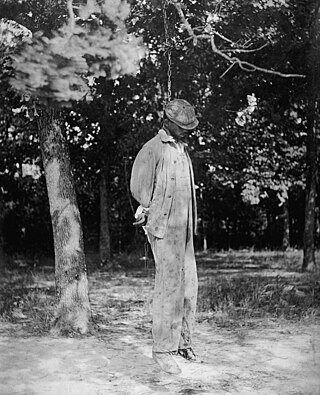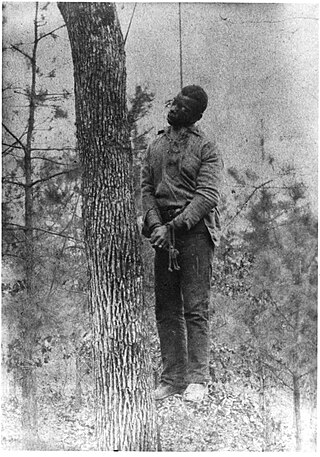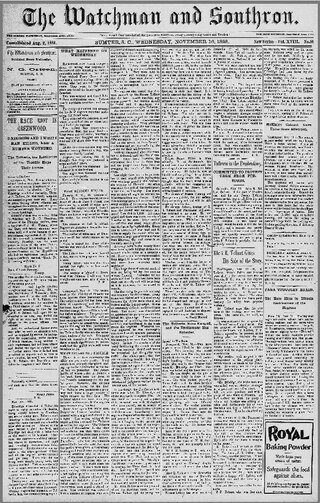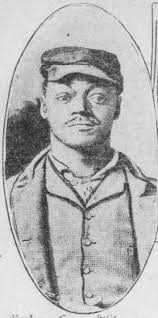Related Research Articles
In the broader context of racism in the United States, mass racial violence in the United States consists of ethnic conflicts and race riots, along with such events as:

Lynching is an extrajudicial killing by a group. It is most often used to characterize informal public executions by a mob in order to punish an alleged transgressor, punish a convicted transgressor, or intimidate people. It can also be an extreme form of informal group social control, and it is often conducted with the display of a public spectacle for maximum intimidation. Instances of lynchings and similar mob violence can be found in every society.

Stroudsburg is a borough and county seat of Monroe County, Pennsylvania, United States. It lies within the Poconos region approximately five miles (8 km) from the Delaware Water Gap at the confluence of Brodhead Creek, McMichaels, and Pocono Creeks in Northeastern Pennsylvania. Stroudsburg is part of the East Stroudsburg, PA Metropolitan Statistical Area, which in turn is part of the New York combined statistical area. The population was 5,927 at the 2020 census.

The New York City draft riots, sometimes referred to as the Manhattan draft riots and known at the time as Draft Week, were violent disturbances in Lower Manhattan, widely regarded as the culmination of working-class discontent with new laws passed by Congress that year to draft men to fight in the ongoing American Civil War. The riots remain the largest civil and most racially charged urban disturbance in American history. According to Toby Joyce, the riot represented a "civil war" within the city's Irish community, in that "mostly Irish American rioters confronted police, [while] soldiers, and pro-war politicians ... were also to a considerable extent from the local Irish immigrant community."

The Omaha Race Riot occurred in Omaha, Nebraska, September 28–29, 1919. The race riot resulted in the lynching of Will Brown, a black civilian; the death of two white rioters; the injuries of many Omaha Police Department officers and civilians, including the attempted hanging of Mayor Edward Parsons Smith; and a public rampage by thousands of white rioters who set fire to the Douglas County Courthouse in downtown Omaha. It followed more than 20 race riots that occurred in major industrial cities and certain rural areas of the United States during the Red Summer of 1919.

Lynching was the widespread occurrence of extrajudicial killings which began in the United States' pre–Civil War South in the 1830s and ended during the civil rights movement in the 1950s and 1960s. Although the victims of lynchings were members of various ethnicities, after roughly 4 million enslaved African Americans were emancipated, they became the primary targets of white Southerners. Lynchings in the U.S. reached their height from the 1890s to the 1920s, and they primarily victimized ethnic minorities. Most of the lynchings occurred in the American South, as the majority of African Americans lived there, but racially motivated lynchings also occurred in the Midwest and border states. In 1891, the largest single mass lynching in American history was perpetrated in New Orleans against Italian immigrants.

Caddo Parish is a parish located in the northwestern corner of the U.S. state of Louisiana. According to the 2020 U.S. census, the parish had a population of 237,848. The parish seat is Shreveport, which developed along the Red River.

The Militia Act of 1862 was an Act of the 37th United States Congress, during the American Civil War, that authorized a militia draft within a state when the state could not meet its quota with volunteers. The Act, for the first time, also allowed African-Americans to serve in the militias as soldiers and war laborers.

Jesse Washington was a seventeen-year-old African American farmhand who was lynched in the county seat of Waco, Texas, on May 15, 1916, in what became a well-known example of lynching. Washington was convicted of raping and murdering Lucy Fryer, the wife of his white employer in rural Robinson, Texas. He was chained by his neck and dragged out of the county court by observers. He was then paraded through the street, all while being stabbed and beaten, before being held down and castrated. He was then lynched in front of Waco's city hall.
Popular opposition to the American Civil War, which lasted from 1861 to 1865, was widespread. Although there had been many attempts at compromise prior to the outbreak of war, there were those who felt it could still be ended peacefully or did not believe it should have occurred in the first place. Opposition took the form of both those in the North who believed the South had the right to be independent and those in the South who wanted neither war nor a Union advance into the newly declared Confederate States of America.
Joe Coe, also known as George Smith, was an African-American laborer who was lynched on October 10, 1891, in Omaha, Nebraska. Overwhelmed by a mob of one thousand at the Douglas County Courthouse, the twelve city police officers stood by without intervening. Afterward, the mayor called the lynching "the most deplorable thing that has ever happened in the history of the country."

The present Douglas County Courthouse is located at 1701 Farnam Street in Omaha, Nebraska, United States. Built in 1912, it was added to the National Register of Historic Places in 1979. Notable events at the courthouse include two lynchings and the city's first sit-in during the Civil Rights Movement. Five years after it was opened, the building was almost destroyed by mob violence in the Omaha Race Riot of 1919.
The Detroit race riot of 1863 occurred on March 6, 1863, in the city of Detroit, Michigan, during the American Civil War. At the time, the Detroit Free Press reported these events as "the bloodiest day that ever dawned upon Detroit." It began due to unrest among the working class related to racism and the military draft, which was heightened after the Emancipation Proclamation was issued by President Abraham Lincoln. Based in a free state, some recent immigrants and other workers resented being drafted for a war that they thought was waged for the benefit of slaves in the Southern United States, and they feared competition from Black people.

The Phoenix election riot occurred on November 8, 1898, near Greenwood County, South Carolina, when a group of local white Democrats attempted to stop a Republican election official from taking the affidavits of African Americans who had been denied the ability to vote. The race-based riot was part of numerous efforts by white conservative Democrats to suppress voting by blacks, as they had largely supported the Republican Party since the Reconstruction era. Beginning with Mississippi in 1890, and South Carolina in 1895, southern states were passing new constitutions and laws designed to disenfranchise blacks by making voter registration and voting more difficult.

The 1891 New Orleans lynchings were the murders of 11 Italian Americans and Italian immigrants in New Orleans by a mob for their alleged role in the murder of police chief David Hennessy after some of them had been acquitted at trial. It was the largest single mass lynching in American history. Most of the lynching victims accused in the murder had been rounded up and charged due to their Italian ethnicity.
In the early hours of 3 June 1893, a black day-laborer named Samuel J. Bush was forcibly taken from the Macon County, Illinois, jail and lynched. Mr. Bush stood accused of raping Minnie Cameron Vest, a white woman, who lived in the nearby town of Mount Zion.

The lynching of Paul Reed and Will Cato occurred in Statesboro, Georgia on August 16, 1904. Five members of a white farm family, the Hodges, had been murdered and their house burned to hide the crime. Paul Reed and Will Cato, who were African-American, were tried and convicted for the murders. Despite militia having been brought in from Savannah to protect them, the two men were taken by a mob from the courthouse immediately after their trials, chained to a tree stump, and burned. In the immediate aftermath, four more African-Americans were shot, three of them dying, and others were flogged.

The lynching of George White occurred on Tuesday, June 23, 1903, in Wilmington, Delaware. White was a black farmer who was accused of the rape and murder of Helen Bishop, who was arrested and brought to the workhouse. On the evening of June 22, under the impression that the local authorities were not reacting severely or soon enough, a large mob of white men marched to the workhouse, broke their way in, and forced White out of his cell. He was then brought to the site of Helen Bishop's death, tied to a stake, and burned. It is often referred to as the only documented lynching in Delaware.
George Marshall Clark was an African American barber in Milwaukee, Wisconsin. On September 6, 1861, Clark was forcibly taken from the city jail in Milwaukee, Wisconsin, questioned, and lynched by a crowd of fifty to seventy-five Irishmen. Marshall Clark, along with another fellow African American named James P. Shelton, had exchanged insults and blows with two Irishmen who accused them of bothering two white women on the street, and Shelton ended up fatally stabbing Irishman Darby Carney. Clark was eventually hanged from a pile driver later that night.

William Andrews was an African American laborer who was lynched by a white mob in Princess Anne, Maryland on June 9, 1897. Andrews, then 17, was tried, convicted, and hanged all in one day after being accused of assaulting Mrs. Benjamin T. Kelley.
References
- Bernstein, Iver (1991). The New York City Draft Riots: Their Significance for American Society and Politics in the Age of the Civil War. Oxford University Press,USA. pp. 1–15. ISBN 978-0-19-992343-4.
- Pfeifer, Michael (December 2010). "The Northern United States and the Genesis of Racial Lynching: The Lynching of African Americans in the Civil War Era". The Journal of American History. 97 (3): 632–635. doi:10.1093/jahist/97.3.621.
- MacMallan, Terrance (March 2009). Habits of Whiteness: A Pragmatist Reconstruction. Indiana University Press. pp. 44–51. ISBN 9780253002884.